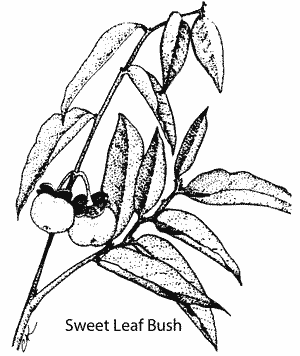From the Archives
of the Rare Fruit Council of Australia, inc.
by David Chandlee

Sweet Leaf Bush I
Scientific Name: Sauropus
androgynus
Family: Phyllanthaceae

Soon after first arrivlng as a visitor to Sabah
in Borneo, I noticed a small upright shrub with purple flowers and
fruits growing in gardens. It had alternately-arranged, 40-60mm long
elliptic dark green leaves, sometimes with a silver blaze, and a
drip-tip. Lauren and I were to see this plant in every garden in every
back (or front) yard in Sabah and Sarawak. Later we found out it is
also commonly grown in Peninsular Malaysia, Sumatra and Java as well.
The plant is 'Sweet leaf bush', ('Changkok manis' or 'sayor manis' in
Malay, Sauropus
androgynus L. Merr.). Soon we ate it in soups with
seasonings and as an accompaniment to rice dishes. We found it sweet
and good-flavoured, with a good texture when cooked.
We sent seeds back to North Queensland and began distributing the
plants in 1985. Five years later, it is growing from Rockhampton on the
Tropic of Capricorn to Cape York Peninsula near the Equator, and is
used by its growers as a steady source of 'spinach' during the warm and
hot months of the year, when green leaves become a luxury imported from
southern Australia. One enthusiast is planting most of one acre in
sweet leaf!
Ease of cultivation, rapid growth, and good taste as well as its high
rate of production and high crude protein levels (varying from 6-9.7%)
are the main features which attract growers to sweet leaf bush.
Gardeners who seek a healthy diet rich in non-meat protein, minerals,
vitamins and fibre will find that if they regularly prune their plants
they can have a constant supply of tasty 'spinach' of good quality.
Any available soil will do for sweet leaf bush, be it clay, loam or
sandy. As long as it is warm, it will tolerate heavy rain or hot sun,
as well as the 95% shade it endures in its native habitat, the
understory in primary rainforest. Fertilizer is not necessary, but it
does respond favourably if mulched. The purplish fruits are edible, as
are the flowers, and some people appreciate the (younger) leaves raw,
though it is more commonly cooked.
In the garden, sweet leaf also is useful as a shade plant to grow other
more tender vegetables underneath, thereby keeping off the hot sun.
It is propagated by seed or cutting, and can be harvested four months
after planting.
Uses: As well as being a good ingredient in stir fried dishes, it is
also good in scrambled eggs, and any dish which calls for parsley or
spinach.
Note: Although the author has yet to hear of it in Australia, in
Malaysia there are occasional reports of headaches caused in some
people by heavy consumption of sweet leaf.
Below is a Table (1) detailing plant analysis. Analysis of some other
foods are given for comparison.
| Table 1 |
| Analysis of
Sweet Leaf Bush (Sauropus androgynus) |
| Moisture Content |
70% |
|
| Crude Protein |
34.8% |
(on Dry Matter
basis) |
| Potassium |
2.77% |
Dried Bananas
1.48% |
| Calcium |
1.0% |
Dried Skim milk
1.3% |
| Phosphorus |
0.61% |
Dried soybeans
0.55% |
| Magnesium |
0.55% |
|
| Iron |
199 PPM |
Dried Parsley
410 PPM |
| Vitamin A |
High (no figs. avail.) |
|
| Vitamin C |
Moderate |
|
| Fibre |
14 - 18% |
|
Back to
Katuk Page
Sweet
Leaf Bush II Page
|
|

